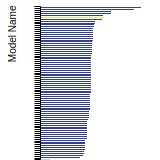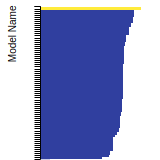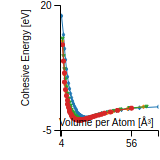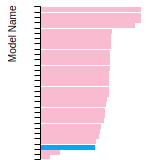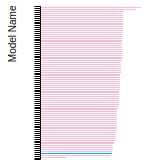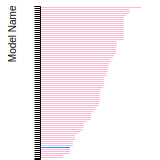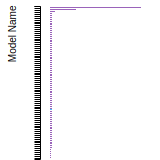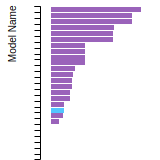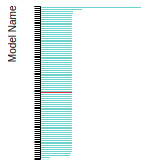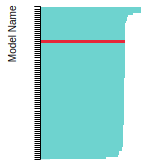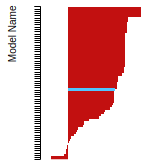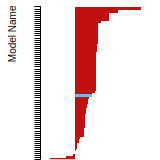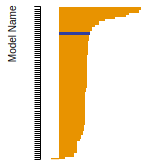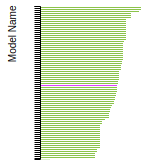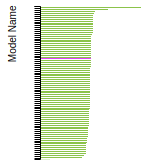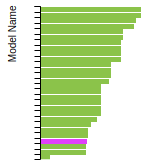 EAM_Dynamo_AngeloMoodyBaskes_1995_NiAlH__MO_418978237058_005
EAM_Dynamo_AngeloMoodyBaskes_1995_NiAlH__MO_418978237058_005
| Title
A single sentence description.
|
EAM potential (LAMMPS cubic hermite tabulation) for the Ni-Al-H system developed by Angelo, Moody and Baskes (1995) v005 |
|---|---|
| Description
A short description of the Model describing its key features including for example: type of model (pair potential, 3-body potential, EAM, etc.), modeled species (Ac, Ag, ..., Zr), intended purpose, origin, and so on.
|
EAM potential for the Ni-Al-H system. Developed to look at H embrittlement in Ni, Al and their alloys, stored in LAMMPS .alloy (setfl) format. This potential produces identical results to both NiAlH_jea.eam.fs and NiAlH_jea.eam.alloy found in the LAMMPS release and dated 2007-11-30. The .fs form of the file stored in LAMMPS does not take advantage of the generality of the Finnis-Sinclair format, and stores identical copies of the electron density functions so that the potential reverts to the simpler .alloy EAM form. Only the .alloy form is stored in OpenKIM. |
| Species
The supported atomic species.
| Al, H, Ni |
| Disclaimer
A statement of applicability provided by the contributor, informing users of the intended use of this KIM Item.
|
None |
| Content Origin | http://www.ctcms.nist.gov/potentials/Ni.html |
| Contributor |
Michael I. Baskes |
| Maintainer |
Michael I. Baskes |
| Developer |
James E Angelo N.R. Moody Michael I. Baskes |
| Published on KIM | 2018 |
| How to Cite |
This Model originally published in [1-2] is archived in OpenKIM [3-6]. [1] Angelo JE, Moody NR, Baskes MI. Trapping of hydrogen to lattice defects in nickel. Modelling and Simulation in Materials Science and Engineering. 1995;3(3):289–307. doi:10.1088/0965-0393/3/3/001 — (Primary Source) A primary source is a reference directly related to the item documenting its development, as opposed to other sources that are provided as background information. [2] Baskes MI, Sha X, Angelo JE, Moody NR. Correction: Trapping of hydrogen to lattice defects in nickel. Modelling and Simulation in Materials Science and Engineering. 1997;5(6):651–2. doi:10.1088/0965-0393/5/6/007 [3] Angelo JE, Moody NR, Baskes MI. EAM potential (LAMMPS cubic hermite tabulation) for the Ni-Al-H system developed by Angelo, Moody and Baskes (1995) v005. OpenKIM; 2018. doi:10.25950/3ea7788d [4] Foiles SM, Baskes MI, Daw MS, Plimpton SJ. EAM Model Driver for tabulated potentials with cubic Hermite spline interpolation as used in LAMMPS v005. OpenKIM; 2018. doi:10.25950/68defa36 [5] Tadmor EB, Elliott RS, Sethna JP, Miller RE, Becker CA. The potential of atomistic simulations and the Knowledgebase of Interatomic Models. JOM. 2011;63(7):17. doi:10.1007/s11837-011-0102-6 [6] Elliott RS, Tadmor EB. Knowledgebase of Interatomic Models (KIM) Application Programming Interface (API). OpenKIM; 2011. doi:10.25950/ff8f563a Click here to download the above citation in BibTeX format. |
| Citations
This panel presents information regarding the papers that have cited the interatomic potential (IP) whose page you are on. The OpenKIM machine learning based Deep Citation framework is used to determine whether the citing article actually used the IP in computations (denoted by "USED") or only provides it as a background citation (denoted by "NOT USED"). For more details on Deep Citation and how to work with this panel, click the documentation link at the top of the panel. The word cloud to the right is generated from the abstracts of IP principle source(s) (given below in "How to Cite") and the citing articles that were determined to have used the IP in order to provide users with a quick sense of the types of physical phenomena to which this IP is applied. The bar chart shows the number of articles that cited the IP per year. Each bar is divided into green (articles that USED the IP) and blue (articles that did NOT USE the IP). Users are encouraged to correct Deep Citation errors in determination by clicking the speech icon next to a citing article and providing updated information. This will be integrated into the next Deep Citation learning cycle, which occurs on a regular basis. OpenKIM acknowledges the support of the Allen Institute for AI through the Semantic Scholar project for providing citation information and full text of articles when available, which are used to train the Deep Citation ML algorithm. |
This panel provides information on past usage of this interatomic potential (IP) powered by the OpenKIM Deep Citation framework. The word cloud indicates typical applications of the potential. The bar chart shows citations per year of this IP (bars are divided into articles that used the IP (green) and those that did not (blue)). The complete list of articles that cited this IP is provided below along with the Deep Citation determination on usage. See the Deep Citation documentation for more information. 
37 Citations (26 used)
Help us to determine which of the papers that cite this potential actually used it to perform calculations. If you know, click the .
USED (high confidence) D. Aksoy, R. Dingreville, and D. Spearot, “An embedded-atom method potential parameterized for sulfur-induced embrittlement of nickel,” Modelling and Simulation in Materials Science and Engineering. 2019. link Times cited: 4 Abstract: The embrittling or strengthening effect of solute atoms at g… read more USED (high confidence) S. Chavoshi and S. Xu, “Nanoindentation/scratching at finite temperatures: Insights from atomistic-based modeling,” Progress in Materials Science. 2019. link Times cited: 37 USED (high confidence) D. Korbmacher, J. V. Pezold, S. Brinckmann, J. Neugebauer, C. Hüter, and R. Spatschek, “Modeling of Phase Equilibria in Ni-H: Bridging the Atomistic with the Continuum Scale,” Open Access Journal. 2018. link Times cited: 4 Abstract: In this paper, we present a model which allows bridging the … read more USED (high confidence) J. Amodeo and K. Lizoul, “Mechanical properties and dislocation nucleation in nanocrystals with blunt edges,” Materials & Design. 2017. link Times cited: 36 USED (high confidence) A. Tehranchi and W. A. Curtin, “Atomistic study of hydrogen embrittlement of grain boundaries in nickel: II. Decohesion,” Modelling and Simulation in Materials Science and Engineering. 2017. link Times cited: 27 Abstract: Atomistic simulations of bicrystal samples containing a grai… read more USED (high confidence) R. Dingreville, D. Aksoy, and D. Spearot, “A primer on selecting grain boundary sets for comparison of interfacial fracture properties in molecular dynamics simulations,” Scientific Reports. 2017. link Times cited: 20 USED (high confidence) M. Stopher, “The effects of neutron radiation on nickel-based alloys,” Materials Science and Technology. 2017. link Times cited: 36 Abstract: The effects of neutron radiation on nickel-based alloys in t… read more USED (high confidence) M. Baskes and M. Ortiz, “Scaling Laws in the Ductile Fracture of Metallic Crystals,” Journal of Applied Mechanics. 2015. link Times cited: 2 Abstract: We explore whether the continuum scaling behavior of the fra… read more USED (high confidence) A. Hunter, R. Zhang, I. Beyerlein, T. Germann, and M. Koslowski, “Dependence of equilibrium stacking fault width in fcc metals on the γ-surface,” Modelling and Simulation in Materials Science and Engineering. 2013. link Times cited: 49 Abstract: A phase field dislocation dynamics model that can model wide… read more USED (high confidence) J. Song, M. Soare, and W. A. Curtin, “Testing continuum concepts for hydrogen embrittlement in metals using atomistics,” Modelling and Simulation in Materials Science and Engineering. 2010. link Times cited: 44 Abstract: Hydrogen embrittlement is a pervasive mode of degradation in… read more USED (high confidence) E. Clouet, “The vacancy - edge dislocation interaction in fcc metals: a comparison between atomic simulations and elasticity theory,” Acta Materialia. 2006. link Times cited: 92 USED (low confidence) S. S. Sharma and A. Parashar, “Effect of helium on thermal transport properties in single- and bi-crystals of Ni: a study based on molecular dynamics,” Journal of Physics D: Applied Physics. 2023. link Times cited: 0 Abstract: Nuclear structures are prone to irradiation-induced defects … read more USED (low confidence) A. Arora, H. Singh, I. Adlakha, and D. Mahajan, “On the role of vacancy-hydrogen complexes on dislocation nucleation and propagation in metals,” Modelling and Simulation in Materials Science and Engineering. 2023. link Times cited: 0 Abstract: New insights are provided into the role of vacancy-hydrogen … read more USED (low confidence) Y. Zheng, L. Cao, J. Huang, and L. Zhang, “Deformation evolution depending on grain boundary type and hydrogen concentration in nickel investigated by molecular dynamics simulation,” Materials Research Express. 2022. link Times cited: 0 Abstract: The impacts of hydrogen concentration on tensile deformation… read more USED (low confidence) W. K. Kim, A. Kavalur, S. Whalen, and E. Tadmor, “Free energy calculation and ghost force correction for hot‐QC,” International Journal for Numerical Methods in Engineering. 2022. link Times cited: 0 Abstract: A new efficient variant of hot‐QC, the finite temperature ve… read more USED (low confidence) Y. Chen, H. Qi, H. Li, S. Shen, Y.-qiang Yang, and C. Song, “Molecular dynamics simulations of the formation and evolution of hydrogen pores during laser powder bed fusion manufacturing,” MRS Communications. 2021. link Times cited: 1 Abstract: Pores in the AlSi10Mg products fabricated by laser powder be… read more USED (low confidence) F. x, L. j, M. Hallil, A. Metsue, A. Oudriss, and J. Bouhattate, “Some Advances on Antagonist Effects of Grain Boundaries between the Trapping Process and the Fast Diffusion Path Investigated on Nickel Bicrystals.” 2021. link Times cited: 1 Abstract:
Hydrogen-grain-boundaries interactions and their role in i… read more USED (low confidence) Y. Fan, W. Wang, and Z. Hao, “Diffusion mechanism in cutting Ni-based alloy containing γ′ phase (Ni3Al) with CBN tool based on MD simulation,” Proceedings of the Institution of Mechanical Engineers, Part B: Journal of Engineering Manufacture. 2021. link Times cited: 3 Abstract: Ni-based alloys are widely used in aerospace because of thei… read more USED (low confidence) D. Chen, L. Costello, C. Geller, T. Zhu, and D. McDowell, “Atomistic modeling of dislocation cross-slip in nickel using free-end nudged elastic band method,” Acta Materialia. 2019. link Times cited: 29 USED (low confidence) A. Turk, D. Bombač, J. J. Rydel, M. Ziętara, P. Rivera-Díaz-del-Castillo, and E. Galindo-Nava, “Grain boundary carbides as hydrogen diffusion barrier in a Fe-Ni alloy: A thermal desorption and modelling study,” Materials & Design. 2018. link Times cited: 35 USED (low confidence) H. N. Pishkenari, F. S. Yousefi, and A. Taghibakhshi, “Determination of surface properties and elastic constants of FCC metals: a comparison among different EAM potentials in thin film and bulk scale,” Materials Research Express. 2018. link Times cited: 22 Abstract: Three independent elastic constants C11, C12, and C44 were c… read more USED (low confidence) X. Zhou, D. Marchand, D. McDowell, T. Zhu, and J. Song, “Chemomechanical Origin of Hydrogen Trapping at Grain Boundaries in fcc Metals.,” Physical review letters. 2015. link Times cited: 74 Abstract: Hydrogen embrittlement of metals is widely observed, but its… read more USED (low confidence) S. Kalidindi, J. A. Gomberg, Z. Trautt, and C. Becker, “Application of data science tools to quantify and distinguish between structures and models in molecular dynamics datasets,” Nanotechnology. 2015. link Times cited: 39 Abstract: Structure quantification is key to successful mining and ext… read more USED (low confidence) P. Cantwell et al., “Estimating the In-Plane Young’s Modulus of Polycrystalline Films in MEMS,” Journal of Microelectromechanical Systems. 2012. link Times cited: 19 Abstract: Polycrystalline films in microelectromechanical systems (MEM… read more USED (low confidence) J. Cho, “Coupled 3D Dislocation Modeling at Nano- and Micro-Scales.” 2017. link Times cited: 4 Abstract: The performance of crystalline materials varies depending on… read more USED (low confidence) A. Tehranchi and W. Curtin, “Atomistic study of hydrogen embrittlement of grain boundaries in nickel: I. Fracture,” Journal of The Mechanics and Physics of Solids. 2017. link Times cited: 85 NOT USED (low confidence) K. Choudhary, A. Biacchi, S. Ghosh, L. Hale, A. Walker, and F. Tavazza, “High-throughput assessment of vacancy formation and surface energies of materials using classical force-fields,” Journal of Physics: Condensed Matter. 2018. link Times cited: 16 Abstract: In this work, we present an open access database for surface… read more NOT USED (low confidence) M. Baskes, X. Sha, J. E. Angelo, and N. Moody, “COMMENT: Trapping of hydrogen to lattice defects in nickel,” Modelling and Simulation in Materials Science and Engineering. 1995. link Times cited: 309 Abstract: This paper addresses the energy associated with the trapping… read more NOT USED (high confidence) J. Li, A. Hallil, A. Metsue, A. Oudriss, J. Bouhattate, and X. Feaugas, “Antagonist effects of grain boundaries between the trapping process and the fast diffusion path in nickel bicrystals,” Scientific Reports. 2021. link Times cited: 9 NOT USED (high confidence) S. Longbottom and P. Brommer, “Uncertainty quantification for classical effective potentials: an extension to potfit,” Modelling and Simulation in Materials Science and Engineering. 2018. link Times cited: 12 Abstract: Effective potentials are an essential ingredient of classica… read more NOT USED (high confidence) L.-F. Wang, X. Shu, G. Lu, and F. Gao, “Embedded-atom method potential for modeling hydrogen and hydrogen-defect interaction in tungsten,” Journal of Physics: Condensed Matter. 2017. link Times cited: 20 Abstract: An embedded-atom method potential has been developed for mod… read more NOT USED (high confidence) S. Huang, D. Chen, J. Song, D. McDowell, and T. Zhu, “Hydrogen embrittlement of grain boundaries in nickel: an atomistic study,” npj Computational Materials. 2017. link Times cited: 48 NOT USED (high confidence) K. L. Baker and D. H. Warner, “Extended timescale atomistic modeling of crack tip behavior in aluminum,” Modelling and Simulation in Materials Science and Engineering. 2012. link Times cited: 17 Abstract: Traditional molecular dynamics (MD) simulations are limited … read more NOT USED (high confidence) B. Henz, T. Hawa, and M. Zachariah, “Molecular dynamics simulation of the kinetic sintering of Ni and Al nanoparticles,” Molecular Simulation. 2009. link Times cited: 47 Abstract: The kinetic sintering of Ni and Al nanoparticles is consider… read more NOT USED (high confidence) H. S. Park, K. Gall, and J. Zimmerman, “Deformation of FCC nanowires by twinning and slip,” Journal of The Mechanics and Physics of Solids. 2006. link Times cited: 299 NOT USED (high confidence) D. Spearot, R. Dingreville, and C. O’Brien, “Atomistic Simulation Techniques to Model Hydrogen Segregation and Hydrogen Embrittlement in Metallic Materials,” Handbook of Mechanics of Materials. 2019. link Times cited: 5 NOT USED (high confidence) J. A. Zimmerman, H. Gao, and F. F. Abraham, “Generalized stacking fault energies for embedded atom FCC metals,” Modelling and Simulation in Materials Science and Engineering. 2000. link Times cited: 27 Abstract: Atomistic calculations for the 112 -generalized stacking fau… read more |
| Funding | Not available |
| Short KIM ID
The unique KIM identifier code.
| MO_418978237058_005 |
| Extended KIM ID
The long form of the KIM ID including a human readable prefix (100 characters max), two underscores, and the Short KIM ID. Extended KIM IDs can only contain alpha-numeric characters (letters and digits) and underscores and must begin with a letter.
| EAM_Dynamo_AngeloMoodyBaskes_1995_NiAlH__MO_418978237058_005 |
| DOI |
10.25950/3ea7788d https://doi.org/10.25950/3ea7788d https://commons.datacite.org/doi.org/10.25950/3ea7788d |
| KIM Item Type
Specifies whether this is a Portable Model (software implementation of an interatomic model); Portable Model with parameter file (parameter file to be read in by a Model Driver); Model Driver (software implementation of an interatomic model that reads in parameters).
| Portable Model using Model Driver EAM_Dynamo__MD_120291908751_005 |
| Driver | EAM_Dynamo__MD_120291908751_005 |
| KIM API Version | 2.0 |
| Potential Type | eam |
| Previous Version | EAM_Dynamo_AngeloMoodyBaskes_1995_NiAlH__MO_418978237058_004 |
| Grade | Name | Category | Brief Description | Full Results | Aux File(s) |
|---|---|---|---|---|---|
| P | vc-species-supported-as-stated | mandatory | The model supports all species it claims to support; see full description. |
Results | Files |
| P | vc-periodicity-support | mandatory | Periodic boundary conditions are handled correctly; see full description. |
Results | Files |
| P | vc-permutation-symmetry | mandatory | Total energy and forces are unchanged when swapping atoms of the same species; see full description. |
Results | Files |
| A | vc-forces-numerical-derivative | consistency | Forces computed by the model agree with numerical derivatives of the energy; see full description. |
Results | Files |
| P | vc-dimer-continuity-c1 | informational | The energy versus separation relation of a pair of atoms is C1 continuous (i.e. the function and its first derivative are continuous); see full description. |
Results | Files |
| P | vc-objectivity | informational | Total energy is unchanged and forces transform correctly under rigid-body translation and rotation; see full description. |
Results | Files |
| P | vc-inversion-symmetry | informational | Total energy is unchanged and forces change sign when inverting a configuration through the origin; see full description. |
Results | Files |
| N/A | vc-memory-leak | informational | The model code does not have memory leaks (i.e. it releases all allocated memory at the end); see full description. |
Results | Files |
| P | vc-thread-safe | mandatory | The model returns the same energy and forces when computed in serial and when using parallel threads for a set of configurations. Note that this is not a guarantee of thread safety; see full description. |
Results | Files |
| P | vc-unit-conversion | mandatory | The model is able to correctly convert its energy and/or forces to different unit sets; see full description. |
Results | Files |
BCC Lattice Constant
This bar chart plot shows the mono-atomic body-centered cubic (bcc) lattice constant predicted by the current model (shown in the unique color) compared with the predictions for all other models in the OpenKIM Repository that support the species. The vertical bars show the average and standard deviation (one sigma) bounds for all model predictions. Graphs are generated for each species supported by the model.
Cohesive Energy Graph
This graph shows the cohesive energy versus volume-per-atom for the current mode for four mono-atomic cubic phases (body-centered cubic (bcc), face-centered cubic (fcc), simple cubic (sc), and diamond). The curve with the lowest minimum is the ground state of the crystal if stable. (The crystal structure is enforced in these calculations, so the phase may not be stable.) Graphs are generated for each species supported by the model.
Diamond Lattice Constant
This bar chart plot shows the mono-atomic face-centered diamond lattice constant predicted by the current model (shown in the unique color) compared with the predictions for all other models in the OpenKIM Repository that support the species. The vertical bars show the average and standard deviation (one sigma) bounds for all model predictions. Graphs are generated for each species supported by the model.
Dislocation Core Energies
This graph shows the dislocation core energy of a cubic crystal at zero temperature and pressure for a specific set of dislocation core cutoff radii. After obtaining the total energy of the system from conjugate gradient minimizations, non-singular, isotropic and anisotropic elasticity are applied to obtain the dislocation core energy for each of these supercells with different dipole distances. Graphs are generated for each species supported by the model.
(No matching species)FCC Elastic Constants
This bar chart plot shows the mono-atomic face-centered cubic (fcc) elastic constants predicted by the current model (shown in blue) compared with the predictions for all other models in the OpenKIM Repository that support the species. The vertical bars show the average and standard deviation (one sigma) bounds for all model predictions. Graphs are generated for each species supported by the model.
FCC Lattice Constant
This bar chart plot shows the mono-atomic face-centered cubic (fcc) lattice constant predicted by the current model (shown in red) compared with the predictions for all other models in the OpenKIM Repository that support the species. The vertical bars show the average and standard deviation (one sigma) bounds for all model predictions. Graphs are generated for each species supported by the model.
FCC Stacking Fault Energies
This bar chart plot shows the intrinsic and extrinsic stacking fault energies as well as the unstable stacking and unstable twinning energies for face-centered cubic (fcc) predicted by the current model (shown in blue) compared with the predictions for all other models in the OpenKIM Repository that support the species. The vertical bars show the average and standard deviation (one sigma) bounds for all model predictions. Graphs are generated for each species supported by the model.
FCC Surface Energies
This bar chart plot shows the mono-atomic face-centered cubic (fcc) relaxed surface energies predicted by the current model (shown in blue) compared with the predictions for all other models in the OpenKIM Repository that support the species. The vertical bars show the average and standard deviation (one sigma) bounds for all model predictions. Graphs are generated for each species supported by the model.
SC Lattice Constant
This bar chart plot shows the mono-atomic simple cubic (sc) lattice constant predicted by the current model (shown in the unique color) compared with the predictions for all other models in the OpenKIM Repository that support the species. The vertical bars show the average and standard deviation (one sigma) bounds for all model predictions. Graphs are generated for each species supported by the model.
Cubic Crystal Basic Properties Table
Species: AlSpecies: H
Species: Ni
Creators:
Contributor: karls
Publication Year: 2019
DOI: https://doi.org/10.25950/64cb38c5
This Test Driver uses LAMMPS to compute the cohesive energy of a given monoatomic cubic lattice (fcc, bcc, sc, or diamond) at a variety of lattice spacings. The lattice spacings range from a_min (=a_min_frac*a_0) to a_max (=a_max_frac*a_0) where a_0, a_min_frac, and a_max_frac are read from stdin (a_0 is typically approximately equal to the equilibrium lattice constant). The precise scaling and number of lattice spacings sampled between a_min and a_0 (a_0 and a_max) is specified by two additional parameters passed from stdin: N_lower and samplespacing_lower (N_upper and samplespacing_upper). Please see README.txt for further details.
| Test | Test Results | Link to Test Results page | Benchmark time
Usertime multiplied by the Whetstone Benchmark. This number can be used (approximately) to compare the performance of different models independently of the architecture on which the test was run.
Measured in Millions of Whetstone Instructions (MWI) |
|---|---|---|---|
| Cohesive energy versus lattice constant curve for bcc Al v004 | view | 4547 | |
| Cohesive energy versus lattice constant curve for bcc Ni v004 | view | 3581 | |
| Cohesive energy versus lattice constant curve for diamond Al v004 | view | 3819 | |
| Cohesive energy versus lattice constant curve for diamond Ni v004 | view | 3760 | |
| Cohesive energy versus lattice constant curve for fcc Al v004 | view | 4845 | |
| Cohesive energy versus lattice constant curve for fcc Ni v004 | view | 4547 | |
| Cohesive energy versus lattice constant curve for sc Al v004 | view | 9057 | |
| Cohesive energy versus lattice constant curve for sc Ni v004 | view | 3720 |
Creators:
Contributor: ilia
Publication Year: 2024
DOI: https://doi.org/10.25950/888f9943
Computes the elastic constants for an arbitrary crystal. A robust computational protocol is used, attempting multiple methods and step sizes to achieve an acceptably low error in numerical differentiation and deviation from material symmetry. The crystal structure is specified using the AFLOW prototype designation as part of the Crystal Genome testing framework. In addition, the distance from the obtained elasticity tensor to the nearest isotropic tensor is computed.
| Test | Test Results | Link to Test Results page | Benchmark time
Usertime multiplied by the Whetstone Benchmark. This number can be used (approximately) to compare the performance of different models independently of the architecture on which the test was run.
Measured in Millions of Whetstone Instructions (MWI) |
|---|---|---|---|
| Elastic constants for AlNi in AFLOW crystal prototype A3B2_hP5_164_ad_d at zero temperature and pressure v000 | view | 135609 |
Creators: Junhao Li and Ellad Tadmor
Contributor: tadmor
Publication Year: 2019
DOI: https://doi.org/10.25950/5853fb8f
Computes the cubic elastic constants for some common crystal types (fcc, bcc, sc, diamond) by calculating the hessian of the energy density with respect to strain. An estimate of the error associated with the numerical differentiation performed is reported.
Creators: Junhao Li
Contributor: jl2922
Publication Year: 2018
DOI: https://doi.org/10.25950/2e4b93d9
Computes the elastic constants for hcp crystals by calculating the hessian of the energy density with respect to strain. An estimate of the error associated with the numerical differentiation performed is reported.
| Test | Test Results | Link to Test Results page | Benchmark time
Usertime multiplied by the Whetstone Benchmark. This number can be used (approximately) to compare the performance of different models independently of the architecture on which the test was run.
Measured in Millions of Whetstone Instructions (MWI) |
|---|---|---|---|
| Elastic constants for hcp H at zero temperature | view | 5168 |
Creators: Junhao Li
Contributor: jl2922
Publication Year: 2019
DOI: https://doi.org/10.25950/d794c746
Computes the elastic constants for hcp crystals by calculating the hessian of the energy density with respect to strain. An estimate of the error associated with the numerical differentiation performed is reported.
| Test | Test Results | Link to Test Results page | Benchmark time
Usertime multiplied by the Whetstone Benchmark. This number can be used (approximately) to compare the performance of different models independently of the architecture on which the test was run.
Measured in Millions of Whetstone Instructions (MWI) |
|---|---|---|---|
| Elastic constants for hcp Al at zero temperature v004 | view | 1305 | |
| Elastic constants for hcp Ni at zero temperature v004 | view | 2069 |
Creators:
Contributor: ilia
Publication Year: 2024
DOI: https://doi.org/10.25950/2f2c4ad3
Computes the equilibrium crystal structure and energy for an arbitrary crystal at zero temperature and applied stress by performing symmetry-constrained relaxation. The crystal structure is specified using the AFLOW prototype designation. Multiple sets of free parameters corresponding to the crystal prototype may be specified as initial guesses for structure optimization. No guarantee is made regarding the stability of computed equilibria, nor that any are the ground state.
Creators:
Contributor: brunnels
Publication Year: 2022
DOI: https://doi.org/10.25950/2c59c9d6
Computes grain boundary energy for a range of tilt angles given a crystal structure, tilt axis, and material.
Creators: Daniel S. Karls and Junhao Li
Contributor: karls
Publication Year: 2019
DOI: https://doi.org/10.25950/2765e3bf
Equilibrium lattice constant and cohesive energy of a cubic lattice at zero temperature and pressure.
Creators: Junhao Li
Contributor: jl2922
Publication Year: 2018
DOI: https://doi.org/10.25950/25bcc28b
Calculates lattice constant of hexagonal bulk structures at zero temperature and pressure by using simplex minimization to minimize the potential energy.
| Test | Test Results | Link to Test Results page | Benchmark time
Usertime multiplied by the Whetstone Benchmark. This number can be used (approximately) to compare the performance of different models independently of the architecture on which the test was run.
Measured in Millions of Whetstone Instructions (MWI) |
|---|---|---|---|
| Equilibrium lattice constants for hcp H | view | 32255 |
Creators: Daniel S. Karls and Junhao Li
Contributor: karls
Publication Year: 2019
DOI: https://doi.org/10.25950/c339ca32
Calculates lattice constant of hexagonal bulk structures at zero temperature and pressure by using simplex minimization to minimize the potential energy.
| Test | Test Results | Link to Test Results page | Benchmark time
Usertime multiplied by the Whetstone Benchmark. This number can be used (approximately) to compare the performance of different models independently of the architecture on which the test was run.
Measured in Millions of Whetstone Instructions (MWI) |
|---|---|---|---|
| Equilibrium lattice constants for hcp Al v005 | view | 17287 | |
| Equilibrium lattice constants for hcp Ni v005 | view | 20916 |
Creators:
Contributor: mjwen
Publication Year: 2024
DOI: https://doi.org/10.25950/9d9822ec
This Test Driver uses LAMMPS to compute the linear thermal expansion coefficient at a finite temperature under a given pressure for a cubic lattice (fcc, bcc, sc, diamond) of a single given species.
| Test | Test Results | Link to Test Results page | Benchmark time
Usertime multiplied by the Whetstone Benchmark. This number can be used (approximately) to compare the performance of different models independently of the architecture on which the test was run.
Measured in Millions of Whetstone Instructions (MWI) |
|---|---|---|---|
| Linear thermal expansion coefficient of fcc Al at 293.15 K under a pressure of 0 MPa v002 | view | 486384 | |
| Linear thermal expansion coefficient of fcc Ni at 293.15 K under a pressure of 0 MPa v002 | view | 820199 |
Creators: Matt Bierbaum
Contributor: mattbierbaum
Publication Year: 2019
DOI: https://doi.org/10.25950/64f4999b
Calculates the phonon dispersion relations for fcc lattices and records the results as curves.
| Test | Test Results | Link to Test Results page | Benchmark time
Usertime multiplied by the Whetstone Benchmark. This number can be used (approximately) to compare the performance of different models independently of the architecture on which the test was run.
Measured in Millions of Whetstone Instructions (MWI) |
|---|---|---|---|
| Phonon dispersion relations for fcc Al v004 | view | 49007 | |
| Phonon dispersion relations for fcc Ni v004 | view | 49103 |
Creators:
Contributor: SubrahmanyamPattamatta
Publication Year: 2019
DOI: https://doi.org/10.25950/b4cfaf9a
Intrinsic and extrinsic stacking fault energies, unstable stacking fault energy, unstable twinning energy, stacking fault energy as a function of fractional displacement, and gamma surface for a monoatomic FCC lattice at zero temperature and pressure.
| Test | Test Results | Link to Test Results page | Benchmark time
Usertime multiplied by the Whetstone Benchmark. This number can be used (approximately) to compare the performance of different models independently of the architecture on which the test was run.
Measured in Millions of Whetstone Instructions (MWI) |
|---|---|---|---|
| Stacking and twinning fault energies for fcc Al v002 | view | 4234352 | |
| Stacking and twinning fault energies for fcc Ni v002 | view | 5465417 |
Creators: Matt Bierbaum
Contributor: mattbierbaum
Publication Year: 2019
DOI: https://doi.org/10.25950/6c43a4e6
Calculates the surface energy of several high symmetry surfaces and produces a broken-bond model fit. In latex form, the fit equations are given by:
E_{FCC} (\vec{n}) = p_1 (4 \left( |x+y| + |x-y| + |x+z| + |x-z| + |z+y| +|z-y|\right)) + p_2 (8 \left( |x| + |y| + |z|\right)) + p_3 (2 ( |x+ 2y + z| + |x+2y-z| + |x-2y + z| + |x-2y-z| + |2x+y+z| + |2x+y-z| +|2x-y+z| +|2x-y-z| +|x+y+2z| +|x+y-2z| +|x-y+2z| +|x-y-2z| ) + c
E_{BCC} (\vec{n}) = p_1 (6 \left( | x+y+z| + |x+y-z| + |-x+y-z| + |x-y+z| \right)) + p_2 (8 \left( |x| + |y| + |z|\right)) + p_3 (4 \left( |x+y| + |x-y| + |x+z| + |x-z| + |z+y| +|z-y|\right)) +c.
In Python, these two fits take the following form:
def BrokenBondFCC(params, index):
import numpy
x, y, z = index
x = x / numpy.sqrt(x**2.+y**2.+z**2.)
y = y / numpy.sqrt(x**2.+y**2.+z**2.)
z = z / numpy.sqrt(x**2.+y**2.+z**2.)
return params[0]*4* (abs(x+y) + abs(x-y) + abs(x+z) + abs(x-z) + abs(z+y) + abs(z-y)) + params[1]*8*(abs(x) + abs(y) + abs(z)) + params[2]*(abs(x+2*y+z) + abs(x+2*y-z) +abs(x-2*y+z) +abs(x-2*y-z) + abs(2*x+y+z) +abs(2*x+y-z) +abs(2*x-y+z) +abs(2*x-y-z) + abs(x+y+2*z) +abs(x+y-2*z) +abs(x-y+2*z) +abs(x-y-2*z))+params[3]
def BrokenBondBCC(params, x, y, z):
import numpy
x, y, z = index
x = x / numpy.sqrt(x**2.+y**2.+z**2.)
y = y / numpy.sqrt(x**2.+y**2.+z**2.)
z = z / numpy.sqrt(x**2.+y**2.+z**2.)
return params[0]*6*(abs(x+y+z) + abs(x-y-z) + abs(x-y+z) + abs(x+y-z)) + params[1]*8*(abs(x) + abs(y) + abs(z)) + params[2]*4* (abs(x+y) + abs(x-y) + abs(x+z) + abs(x-z) + abs(z+y) + abs(z-y)) + params[3]
| Test | Test Results | Link to Test Results page | Benchmark time
Usertime multiplied by the Whetstone Benchmark. This number can be used (approximately) to compare the performance of different models independently of the architecture on which the test was run.
Measured in Millions of Whetstone Instructions (MWI) |
|---|---|---|---|
| Broken-bond fit of high-symmetry surface energies in fcc Al v004 | view | 21369 | |
| Broken-bond fit of high-symmetry surface energies in fcc Ni v004 | view | 29526 |
Creators:
Contributor: efuem
Publication Year: 2023
DOI: https://doi.org/10.25950/fca89cea
Computes the monovacancy formation energy and relaxation volume for cubic and hcp monoatomic crystals.
| Test | Test Results | Link to Test Results page | Benchmark time
Usertime multiplied by the Whetstone Benchmark. This number can be used (approximately) to compare the performance of different models independently of the architecture on which the test was run.
Measured in Millions of Whetstone Instructions (MWI) |
|---|---|---|---|
| Monovacancy formation energy and relaxation volume for fcc Al | view | 344838 | |
| Monovacancy formation energy and relaxation volume for fcc Ni | view | 355955 |
Creators:
Contributor: efuem
Publication Year: 2023
DOI: https://doi.org/10.25950/c27ba3cd
Computes the monovacancy formation and migration energies for cubic and hcp monoatomic crystals.
| Test | Test Results | Link to Test Results page | Benchmark time
Usertime multiplied by the Whetstone Benchmark. This number can be used (approximately) to compare the performance of different models independently of the architecture on which the test was run.
Measured in Millions of Whetstone Instructions (MWI) |
|---|---|---|---|
| Vacancy formation and migration energy for fcc Al | view | 691002 | |
| Vacancy formation and migration energy for fcc Ni | view | 1409464 |
| Test | Error Categories | Link to Error page |
|---|---|---|
| Elastic constants for diamond Ni at zero temperature v001 | other | view |
EquilibriumCrystalStructure__TD_457028483760_002
LatticeConstantCubicEnergy__TD_475411767977_006
| Test | Error Categories | Link to Error page |
|---|---|---|
| Equilibrium zero-temperature lattice constant for diamond Al | other | view |
| Equilibrium zero-temperature lattice constant for diamond Ni | other | view |
LatticeConstantHexagonalEnergy__TD_942334626465_005
| Test | Error Categories | Link to Error page |
|---|---|---|
| Equilibrium lattice constants for hcp H v005 | other | view |
| EAM_Dynamo_AngeloMoodyBaskes_1995_NiAlH__MO_418978237058_005.txz | Tar+XZ | Linux and OS X archive |
| EAM_Dynamo_AngeloMoodyBaskes_1995_NiAlH__MO_418978237058_005.zip | Zip | Windows archive |
This Model requires a Model Driver. Archives for the Model Driver EAM_Dynamo__MD_120291908751_005 appear below.
| EAM_Dynamo__MD_120291908751_005.txz | Tar+XZ | Linux and OS X archive |
| EAM_Dynamo__MD_120291908751_005.zip | Zip | Windows archive |
